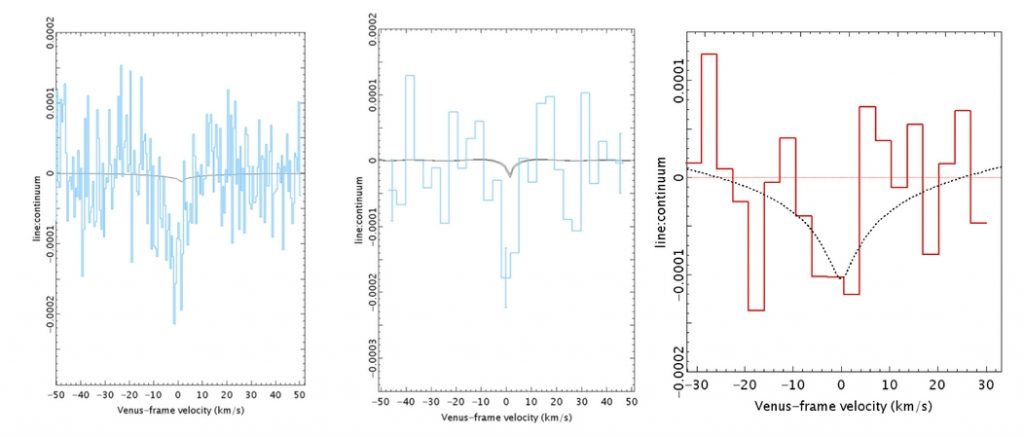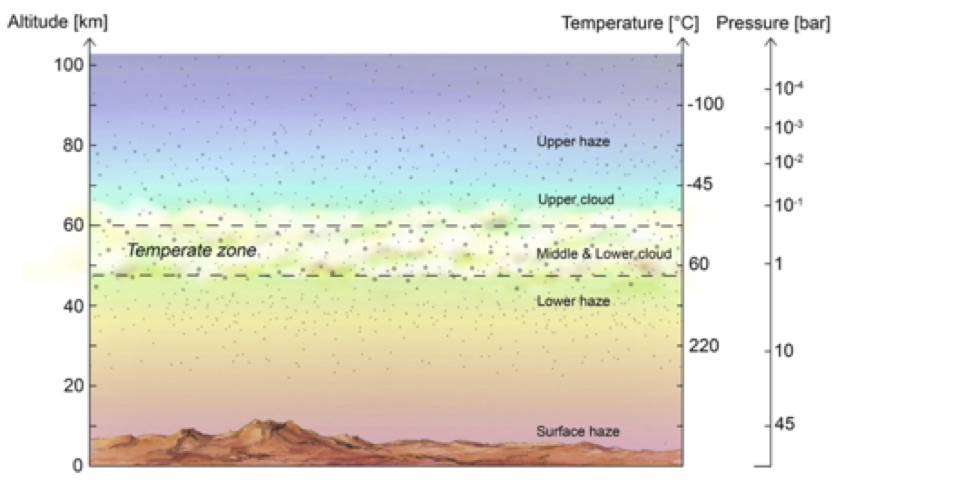JCMT-Venus is a long term programme to study the molecular content of the atmosphere of Venus. This has been prompted by the unexpected discovery of phosphine, PH3, in the planet’s cloud decks by observations at 267 GHz from the JCMT with RxA, from ALMA, and from JCMT with the new ’U’u ̄ receiver (see Fig. 1). While there remains some controversy about these detections and suggestions that the line might be a misidentified SO2 feature, there are strong arguments that the line is both real and PH3, not a misidentification. Independent, in situ confirmation of the presence of PH3 from the Pioneer Venus Probe Mass Spectrometer LMNS supports this conclusion.

Figure 1: The Phosphine 1.123mm 1-0 line as detected by ALMA (left) and JCMT with RxA (middle) and (right) in a preliminary reduction of 30 minutes of ’U’u ̄ observations. The black lines in the JCMT and ALMA spectra indicate the level of SO2 absorption derived from simultaneous (ALMA) and near-simultaneous observations of a different SO2 line. The black line in the rightmost spectrum indicates a 15 ppm model for phosphine absorption (Greaves et al., 2021 & refs therein).
The presence of phosphine in the atmosphere of Venus is something of a mystery, since, according to all normal chemical-production processes, this molecule should not be there at all. Even exotic processes invoking volcanism, lightning, or injection from impactors are incapable of producing the
∼15 ppb quantities of PH3 seen in observations. We are left with the possibility that the PH3 is generated by as-yet unknown chemical processes, which seems unlikely, or the even more speculative proposition that the source of phosphine is biological – i.e. PH3 is a marker for the presence of life in the upper atmosphere of Venus, our nearest neighbour planet, even though the conditions in these clouds are hostile to all known forms of life (see Fig. 2).

Figure 2: A schematic diagram of the vertical structure of the atmosphere of Venus (Seager et al., 2021).
Much remains to be determined about the phosphine in Venus’ atmosphere. The altitude at which the molecules reside is highly uncertain, with a strongly decreasing gradient above the cloud tops likely given non-detections in the near- & mid-IR, and we know little about any temporal or spatial variation.
The JCMT-Venus project will use ’U’u ̄ to monitor PH3 and several other species, including HDO, SO, HCO+ and SO2 over a range of timescales, from hours to years. We already know the abundance of several of these species varies with time, but we do not know the degree to which phosphine varies, or if any variation is correlated with other species or with other factors such as illumination phase. Correlations, or anticorrelations, between phosphine and other species will provide clues to the processes that produce phosphine. These observations will additionally provide legacy information on the variability of other molecular species and higher S/N observations of phosphine line wings, thanks to multiple observations and the improved stability of ’U’u ̄ over RxA. This will allow us to better determine the height in the atmosphere at which PH3 absorption takes place, resolving one of the current major uncertainties in our understanding of PH3.
References: Greaves et al., 2021, ApJ, submitted, arXiv:2108.08393; Seager et al., 2021, arXiv:2009.06474;
Coordinators: David Clements (UK), Jane Greaves (UK), Masataka Imai (Japan), Kitiyanee Asanok (Thailand), Gerald Schieven (Canada), and Steve Mairs (EAO)
– JCMT program code: M22AL006





